Introduction
In yet another heroic feat, our Toyota Corolla made it all the way up the rocky road to the trailhead. However, there was no chance of us driving into the campground, so we grabbed our packs and walked into camp. We met Glenn, a veteran trail crew leader for decades, and the camp cook, Betsy. We set up our tent in a small clearing surrounded by mushrooms. We met our neighbors – downstream was Pat from Kansas City, and closer to the road were Natalie and William from Boulder. Everyone meandered to the pair of big canvas tents as a light misty rain started- rain that would stay with us for most of the next week. We met more of our fellow crew members, a mix of first timers, like us, and some who had joined a crew or two every summer for decades.
I first hiked through this exact spot two years earlier on my thru hike of the Colorado Trail. Near the end of the Collegiate Peaks Wilderness Area, I had arrived at the trailhead to find beautiful trail magic of cold drinks, fresh fruit, and conversation with a trail angel. I resolved then to come back to this spot and pay it forward to future classes of hikers, and had returned with my wife Liz to give some trail magic the year before. This time, however, we were joining a volunteer trail crew with the Colorado Trail Foundation (CTF) for a week of rerouting switchbacks, clipping willows, and building a new bridge. We were aiming to complete a realignment before the already-announced Grand Opening at the end of the week.
Gathering the Crew and Moving Dirt
Once the whole crew was gathered, Glenn gave us all the brief, going over our goals and plans for the week, as well as logistics like camp chores and meal times. We went over the basics of trail maintenance, with a safety brief and set of instructions for each tool.

The next morning, we split into two groups – Brooks, another trail crew leader, would take eight volunteers to clip back the willows and redig the drainages for a section of trail. The remaining dozen climbed up to the top of the pass to rework some eroding switchbacks. My wife and I were in the second group, so we donned our green Colorado Trail Foundation helmets, grabbed a pair of tools, and started up the 3.5 mile trail from the campground to the 12,000 foot pass.
We climbed an old railroad grade up the side of the valley to the old tunnel, then up steep switchbacks the last half mile. We dropped our tools and caught our breath as the crew leaders showed us what they envisioned for our work. Once ready, we grabbed our tools and started moving some dirt.
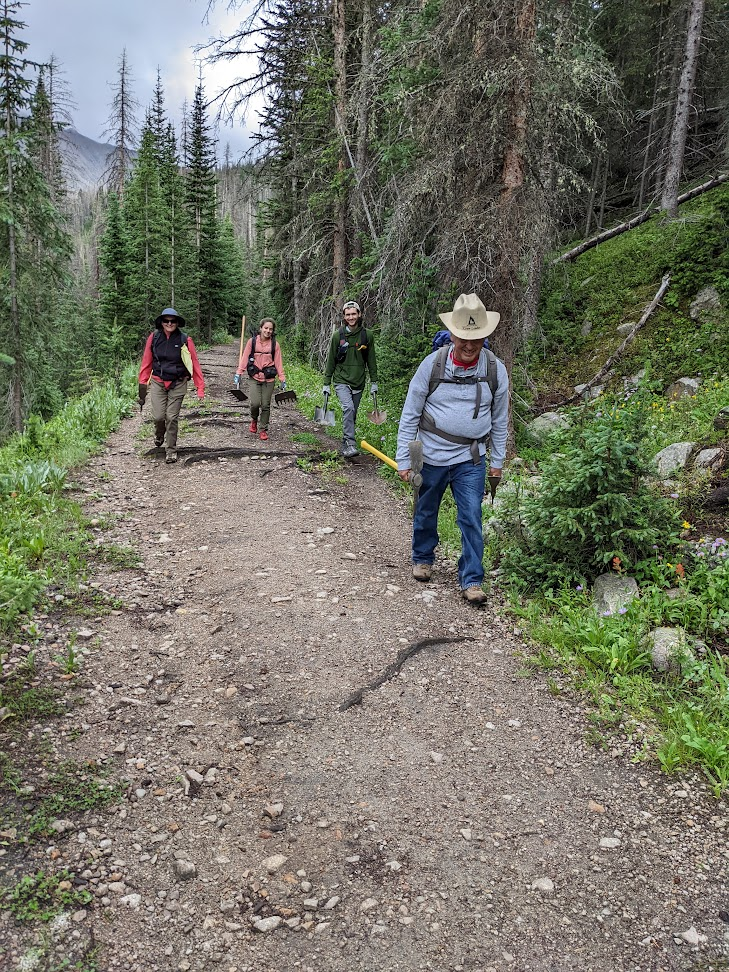
On Trails and Water
A well built trail must contend with its arch nemesis: water. The area which we were working had recently failed the test of summer rains and snow melt, turning into a flash-flood carved mud canyon dropping steeply down the side of the mountain. This can happen when the angle of the trail is too close to the fall line – the path water takes when flowing downhill. Our mission was to create a new set of switchbacks which would live in better harmony with the watershed of the pass, allowing water to flow over the side of the trail instead of flowing down the middle of it.

We started on the grassy section, building a new track that sloped in just the right way to allow water to run off the trail rather than run down the trail. We removed the spongy organic matter, then filled in the tread with mineral soil from a “borrow pit”, a hidden hole we had dug for such a purpose. Pick mattocks and pickaxes cut the sod, shovels and Mcleods moved dirt and pounded in the new tread, and rockbars removed the rocks in our way. All the while we filled in the old water-worn tread. While we had learned the terminology in the brief, we began to understand the big ideas of trail maintenance: the proper angle for the backslope, the necessity of a well built critical edge. Our crew leaders helped us get the right angles and taught us the tricks of the trade – if you can’t stand your Mcleod on the new tread, it’s too steep!
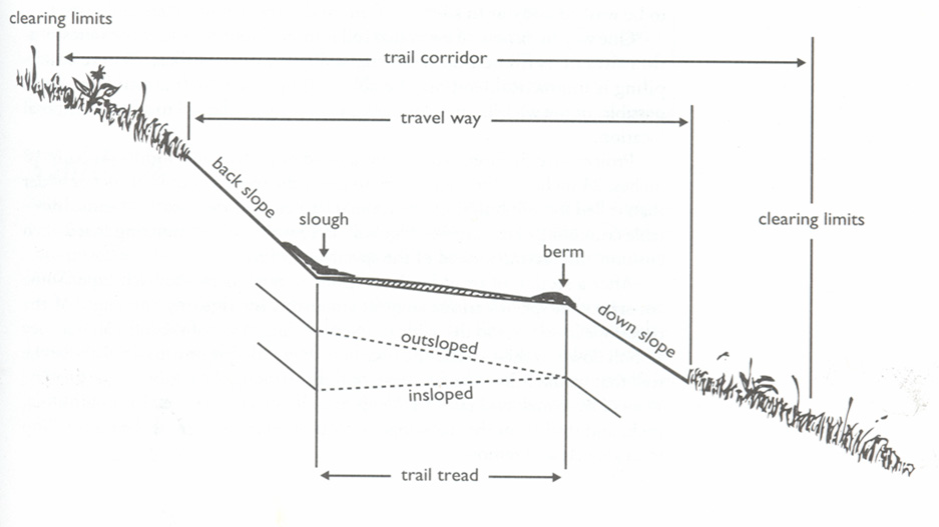
Lunch on the Rocks
We soon had extended our new track to the rocky section, the spot the former trailbuilders were no doubt attempting to avoid with their original steeper path. Our progress slowed considerably as we wrestled with the granite and found a way around the biggest boulders. By the time we had established a foothold in the rocks, it was time to take advantage of some brief sun and break for lunch.

After some afternoon progress into the rocks, we stashed most of our tools in the bushes and hiked back down to base camp, admiring the willow-cutting work of the other team along the way. After accounting for people and tools, we broke for the afternoon. Liz identified the mushrooms around our campsite with her foraging books as I read in our tent. Soon enough the dinner bell rang, and we all lined up to receive the meal Betsy and her helpers had for us.
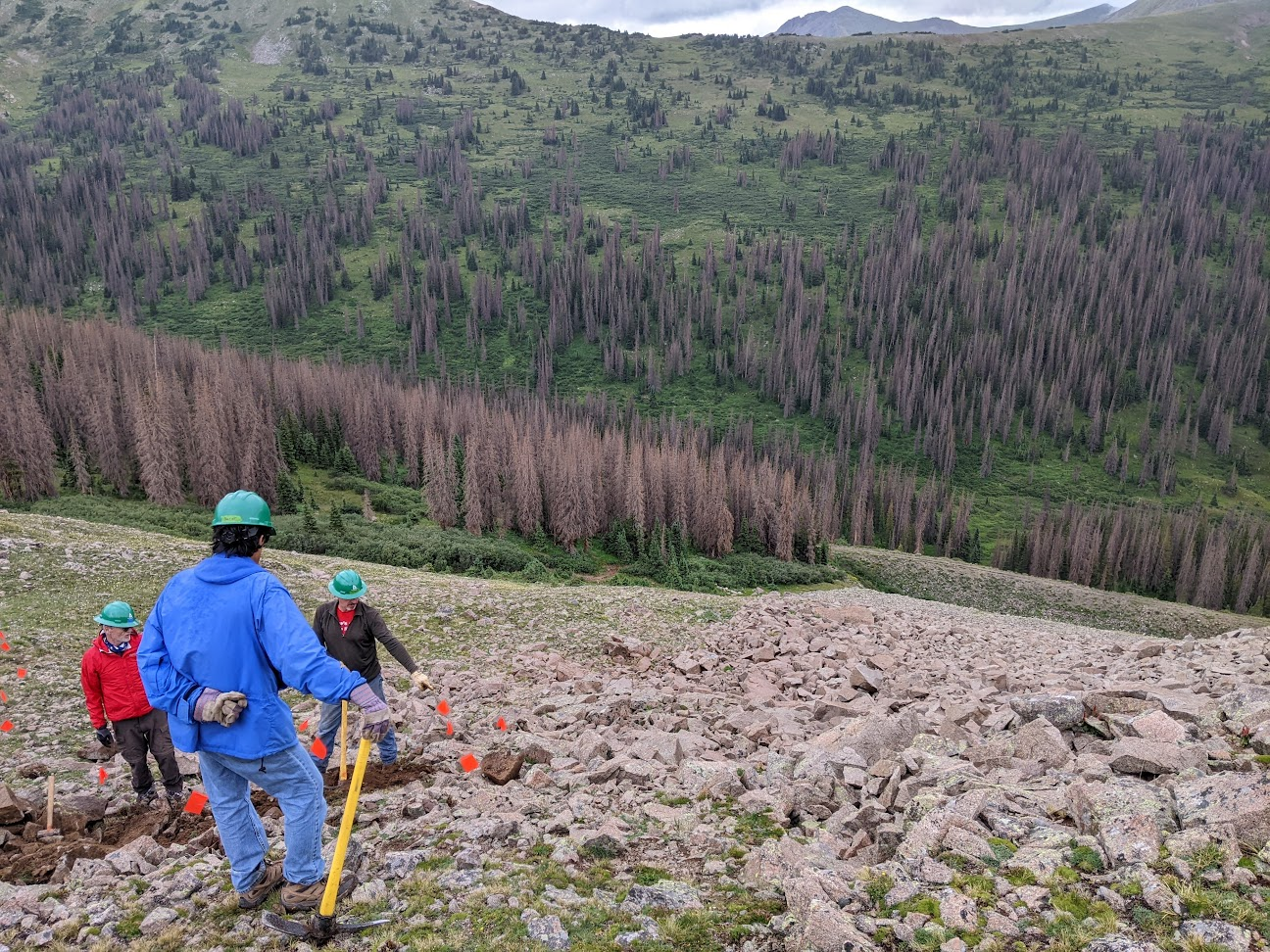
Switchbacks and Storm Clouds
Trail maintenance is in many ways the antithesis of backpacking light – a base camp full of camper trailers, heavy equipment, low miles. We spent four or five hours working, plus an hour commute each way, then spent the rest of time hanging out with the crew in camp. I was expecting more Colorado Trail finishers, but our group was made of people of all walks of life. Most had volunteered with multiple crews before but had little to no experience backpacking on the trail. However, everyone seemed to share the same sentiment: “How lucky are we, that we get to spend a week in this breathtaking place?”
We continued working on the new switchback, pounding a pair of flat rock steps out with various hammers before turning the tread back into the sod. We cut drainage spouts, so any water that did take the trail would only go a few feet before escaping off the side of the mountain. One morning, we watched and listened to a herd of elk move along the ridge on the opposite edge of the valley, and we were joined at the worksite every day by Yellow-bellied Marmots, Magpies, Ravens, Pika, and even a glimpse of some species of mustelid, likely an American Ermine or Long-tailed Weasel.
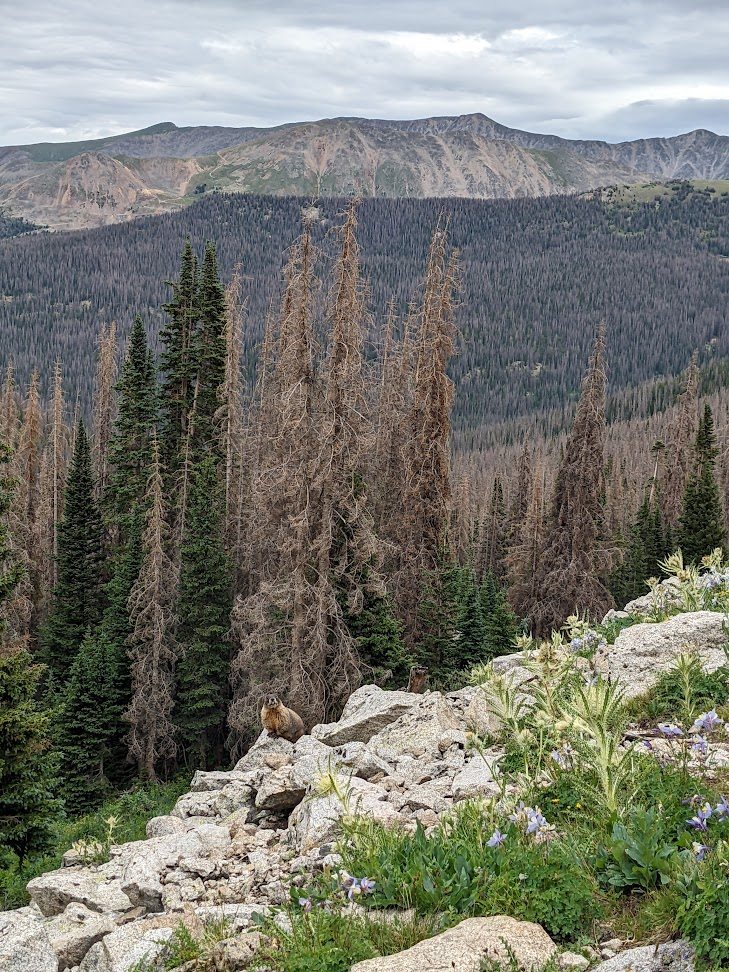
After three days of work, our new switchback was complete- and not a moment too soon. As soon as we had picked up the last of the flags and tools and started our trek back to base camp, a thunderstorm rolled up onto the pass and chased us down. We tossed our iron tools and ran for the treeline, huddling under the biggest spruce trees we could find. Glenn claims he set the world record for Mcleod Toss when he heard the first thunder crack directly overhead. I felt like a turtle retreating inside my shell as the hail pelted my helmet and backpack.
The storm was as short as it was intense, and soon we were cautiously making our way down again. We collected the tossed tools and accounted for everyone, then hiked into camp, still buzzing from the adrenaline rush. We passed a group of Continental Divide thru hikers who had set up a tiny tarp to weather the storm and invited them down to camp for dinner. As much as I love backpacking, it was very nice to have fresh, dry clothes and a good hot meal waiting for us. Over dinner we swapped stories of how we each experienced the storm. Soon, whiskey, wine and beer were produced and shared around the fire.

Mount Princeton Hot Springs
On Wednesday, the crew took our midweek day off, with almost everyone choosing to soak at Mount Princeton Hot Springs just down the mountain. A popular resupply and zero-day spot for thru hikers, we saw many backpackers laying their gear out to dry in the sun in the large lawn in front of the resort. Built just at the mouth of the canyon, there were various sizes of warm and hot man made pools. Some were built with kids and families in mind, with water slides and diving boards, while others were restricted to adults and had names like “Relaxation Pool.” We could also climb down into the rock pools, where ice cold Chalk Creek mixed with the hottest of the spring water. Moving your body a few inches left or right could change the temperature drastically, and there was an art to stacking the rocks to get just the right balance of hot and cold. As we basked in the sun and hot water, we watched cumulonimbus clouds build and burst on our worksite.
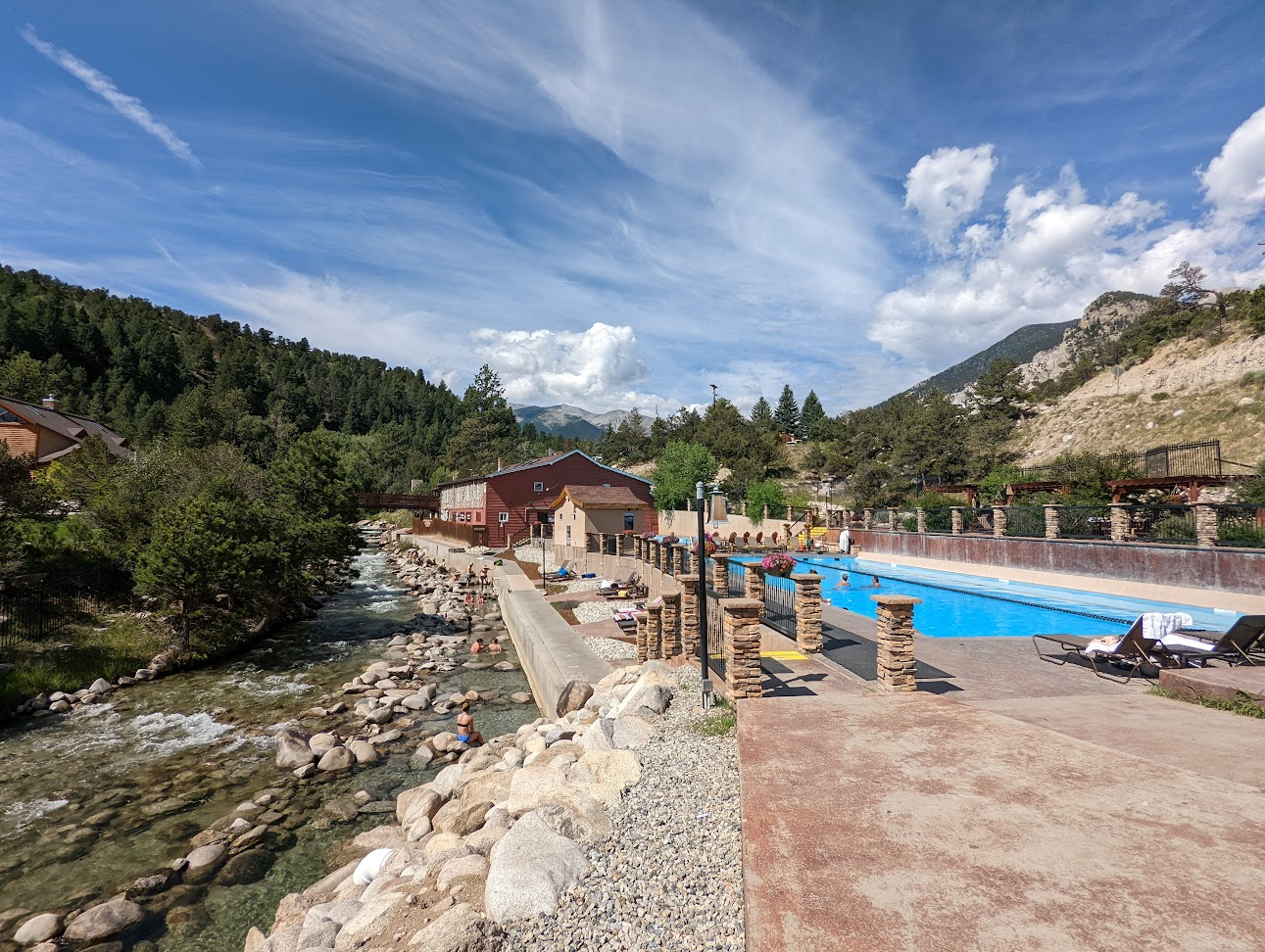
Thursday morning we drove back up to camp early in order to arrive before the food was packed up. While it was our third time driving up the canyon that week, we still marveled at the Chalk Cliffs that were created by mineral deposits from water heated by the same geologic feature that had heated our soaking pools the day before. We passed the ghost and semi-ghost towns, the mine tailings and abandoned equipment from the gold prospecting that had first carved a road up into the high country. We arrived at camp in time for a light breakfast and packed our snacks and sandwiches – me a peanut butter, banana and honey sandwich, Liz a more conventional PB&J.
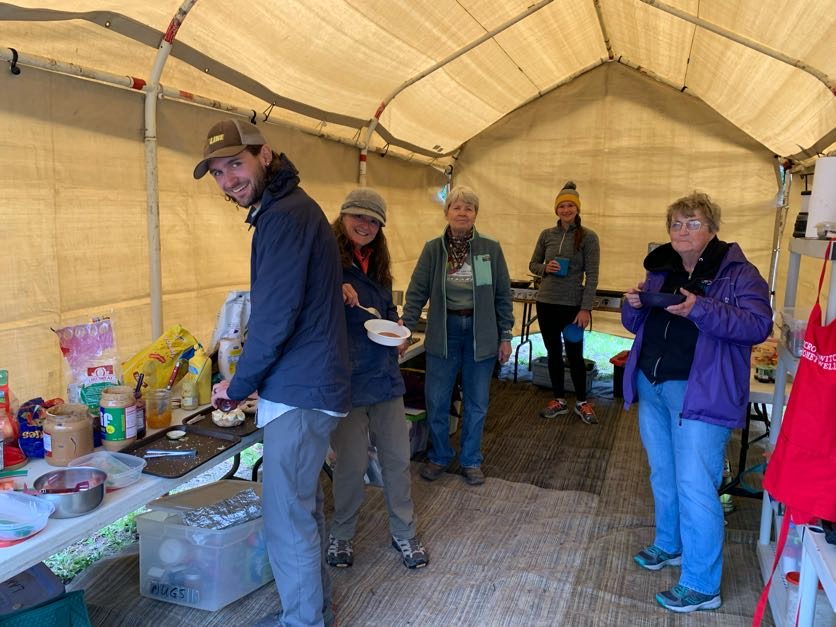
Back to Work
Today we had a different job breakdown for the crew. With the switchback finished and the willows cut back on the rail-to-trail section, we had three groups. Glenn has a reputation for crews that build outstanding bridges, so he took the main group to replace an ailing bridge. A CTF pickup met them with the lumber and heavier tools. A second group walked the realignment set for a Grand Opening on Saturday, removing stumps and cutting back trees. The standard for the Colorado Trail has horseback riders in mind, who require a much wider and taller tunnel than us bipedal trail users.
I went with the last group almost all the way up to the new switchback. The four of us worked our way downhill, fixing the areas that had been flagged by our crew leaders. We dug borrow pits to fill in holes in the railroad bed to the tune of Pika screams and Marmot whistles. The week of on-and-off rain showed areas where water was not draining off the trail as desired. We cleared old drains clogged with sediment and built new waterbars.
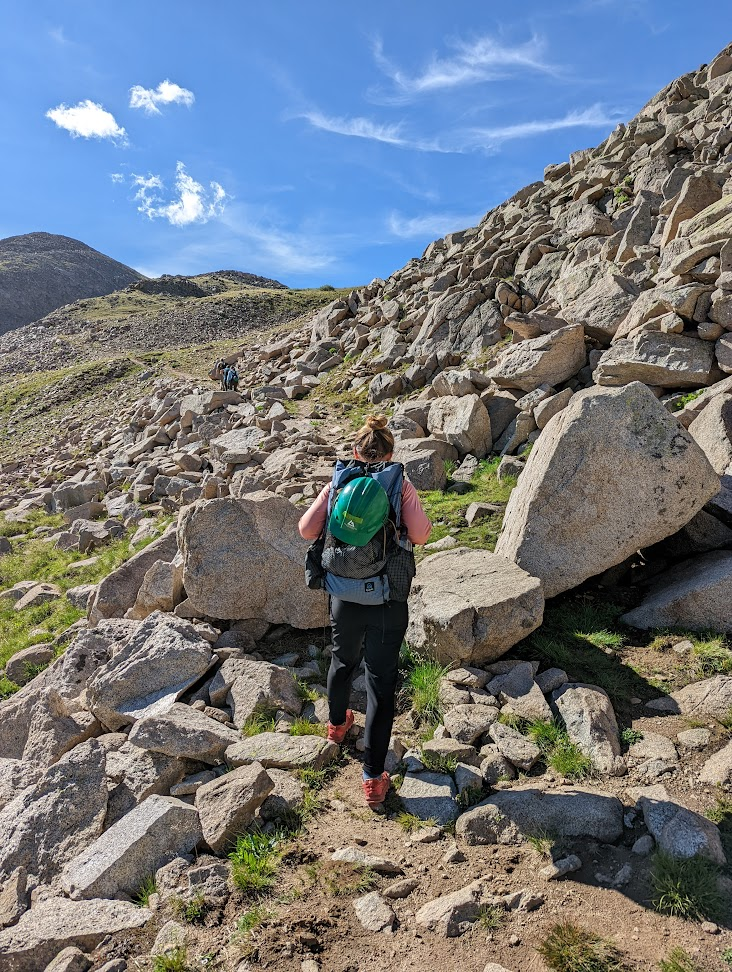
After fixing the last flagged spot in our jurisdiction, we met up with the group on the realignment and helped them finish up. This section of trail moved the Colorado Trail travelers off of the more trafficked rail-to-trail section earlier and removed the need for a tough road walk. We prettied up the section for the VIPs that would be coming on Saturday for the Grand Opening before returning to camp.
Glenn and friends soon returned from bridge building, and we hung out for a last night in camp. We had originally planned to work Friday and attend the Grand Opening on Saturday, but the crew had finished all necessary work by Thursday afternoon. Some stayed to hike in the area and attend the ribbon cutting, but we helped break camp and drove home early after receiving our Trail Crew Volunteer certificates and handshakes from Glenn.

There is something about looking back at your work and seeing the progress, seeing day hikers and thru hikers using the trail you helped build, that is good for my soul. I look forward to my next trail crew days this coming summer. Spending a week with people who love the outdoors enough to spend a week doing unpaid manual labor is a special opportunity. I encourage anyone who has a special connection with a trail or natural area to see what opportunities they have to give back- it may just be good for your soul, too.
Read More
- PLACES: For another story along the Colorado Trail, read this article by Nikki Staville.
- CULTURE: Ben Kilbourne spent some time on the Colorado Trail during a pandemic and fire challenged 2021, and wrote this article where he muses about those challenges.
- FORUM: Read another discussion and story about trail work on the Colorado Trail Foundation from 2013 here.
- FORUM: What gear should I take with me when working on a trail crew? Read this discussion to find out.




Home › Forums › Clouds and McLeods